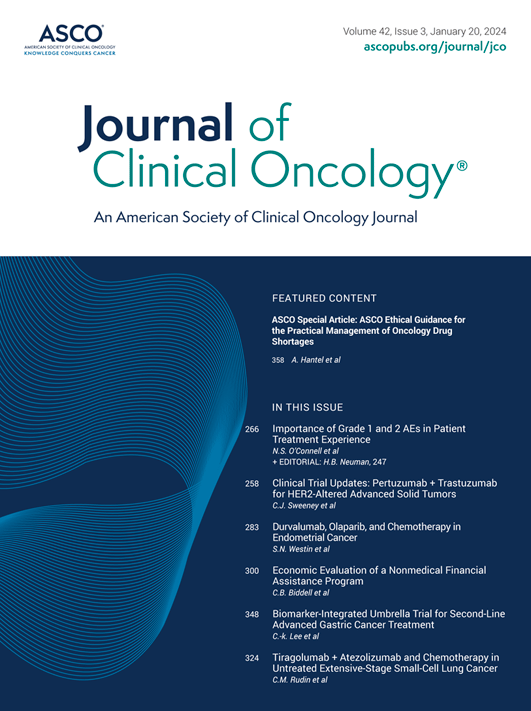Inotuzumab Ozogamicin Then Blinatumomab for Older Adults With Newly Diagnosed B-Cell ALL: Alliance Study A041703 Cohort 1 Results.
IF 41.9
1区 医学
Q1 ONCOLOGY
引用次数: 0
Abstract
PURPOSE Older patients with ALL receiving conventional chemotherapy have poor survival due to toxic death and relapse. We hypothesized that a chemotherapy-free, targeted regimen using the anti-CD22 antibody-calicheamicin conjugate inotuzumab ozogamicin followed by the bispecific anti-CD19/CD3 T-cell engager blinatumomab would reduce toxic death and yield high rates of prolonged remission and survival. METHODS Eligible patients were age 60 years and older with untreated, Philadelphia chromosome (Ph)-negative, CD22-positive, B-cell ALL. Patients received up to two cycles of inotuzumab ozogamicin followed by four or five cycles of blinatumomab with intrathecal methotrexate CNS prophylaxis. The primary end point was 1-year event-free survival (EFS). RESULTS The 33 eligible patients had a median age of 71 years (range, 60-84) and a median CD22 expression of 92% (range, 21%-100%). Eight (24%) had previous chemotherapy or radiation for other cancers, six for multiple myeloma. The composite complete remission rate was 85% after two cycles of inotuzumab ozogamicin and 97% by the end of two cycles of blinatumomab. At a median follow-up of 30 months, the 1-year EFS and overall survival were 75% (95% CI, 61 to 92) and 85% (95% CI, 73 to 98), respectively. EFS was shorter with lower CD22 expression or detectable measurable residual disease at any time point. CONCLUSION Inotuzumab ozogamicin then blinatumomab without maintenance chemotherapy in older patients with untreated, Ph-negative, CD22-positive, B-cell ALL yields a high remission rate and excellent EFS. Given the lack of standard, safe, and effective therapies in this population, the regimen should be considered a standard treatment option.联合研究A041703队列1结果:Inotuzumab Ozogamicin and blinatumumab治疗新诊断的老年b细胞ALL
目的:接受常规化疗的老年急性淋巴细胞白血病患者由于中毒性死亡和复发,生存率较差。我们假设,使用抗cd22抗体-calicheamicin结合inotuzumab ozogamicin的无化疗靶向方案,然后使用双特异性抗cd19 /CD3 t细胞接触者blinatumomab,将减少毒性死亡,并产生高的延长缓解和生存率。方法60岁及以上未经治疗、费城染色体(Ph)阴性、cd22阳性、b细胞ALL患者。患者接受最多2个周期的inotuzumab ozogamicin,随后4或5个周期的blinatumumab加鞘内甲氨蝶呤CNS预防。主要终点为1年无事件生存期(EFS)。结果33例符合条件的患者中位年龄为71岁(范围60-84岁),CD22中位表达率为92%(范围21%-100%)。8人(24%)曾因其他癌症接受过化疗或放疗,6人因多发性骨髓瘤接受过放疗。复合完全缓解率在inotuzumab ozogamicin两个周期后为85%,在blinatumumab两个周期结束时为97%。在中位随访30个月时,1年EFS和总生存率分别为75% (95% CI, 61 - 92)和85% (95% CI, 73 - 98)。在任何时间点,EFS较短,CD22表达较低或可检测到可测量的残留疾病。结论对未经治疗、ph阴性、cd22阳性、b细胞ALL的老年患者,采用ozogamicin与blinatumumab联合非维持性化疗可获得高缓解率和良好的EFS。鉴于该人群缺乏标准、安全、有效的治疗方法,该方案应被视为一种标准治疗方案。
本文章由计算机程序翻译,如有差异,请以英文原文为准。
求助全文
约1分钟内获得全文
求助全文
来源期刊

Journal of Clinical Oncology
医学-肿瘤学
CiteScore
41.20
自引率
2.20%
发文量
8215
审稿时长
2 months
期刊介绍:
The Journal of Clinical Oncology serves its readers as the single most credible, authoritative resource for disseminating significant clinical oncology research. In print and in electronic format, JCO strives to publish the highest quality articles dedicated to clinical research. Original Reports remain the focus of JCO, but this scientific communication is enhanced by appropriately selected Editorials, Commentaries, Reviews, and other work that relate to the care of patients with cancer.
 求助内容:
求助内容: 应助结果提醒方式:
应助结果提醒方式:


